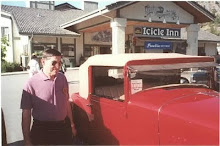Enough meandering-
As Jean's condition progressed the ivory tower savants at University of Oregon followed by the University of Washington were able to treat the symptoms but appeared to be at a loss to come up with the underlying condition that gave rise to the problem.
Again our neighbor and friend in Walla Walla, Dr. McClellen, solicited his friend Dr. Hendricks to intervene.
Herb Hendricks specialized in rehab and sports medicine. Operating the rehab facility in the hospital he frequently checked in on Jean when she was an in patient. He became aware of a frequent complaint of a pain in her back.
He invited her to do a series of tests with a device that located sources of pain. From the results of the test, he drew a map on her back pinpointing the most responding area.
Back to the U of W Hospital. Dr. Kelly, chief of neurosurgery looked at the map. A session with the flouroscope confirmed his "Aha".
The problem was a syringomylia. This is a cyst formed in the spinal cord known as a syrinx that expands and elongates over time and presses against the spinal cord causing a weakness in the extremities. This is often due to a congenital abnormality of the brain called a chiara 1 malformation.
The treatment of choice was to take a bit of muscle and place it over the entrance to the cyst. This is mycroscopic surgery of the most complex nature.
Actually, when the gurney arrived to take Jean to the operating room, she refused to go. She turned to me and said, '" I don't think I want to do this." She then asked what I thought she should do. As her closest advisor and rock of stability I responded that it was her call.
Dr. Kelly came to the room and spoke again of the risks of the procedure and avered that he didn't blame her for being reluctant and explained the downsides of not doing the surgery. He told her that the operating team was assembled and would await her decision. About twenty minutes later he came back and she consented to go ahead.
The operation was only partialy successful. The patch was gingerly put in place at the base of the brain but subsequent scans showed that there was not a perfect seal and some spinal fluid was still seeping into the cyst.
As Jean's condition progressed the ivory tower savants at University of Oregon followed by the University of Washington were able to treat the symptoms but appeared to be at a loss to come up with the underlying condition that gave rise to the problem.
Again our neighbor and friend in Walla Walla, Dr. McClellen, solicited his friend Dr. Hendricks to intervene.
Herb Hendricks specialized in rehab and sports medicine. Operating the rehab facility in the hospital he frequently checked in on Jean when she was an in patient. He became aware of a frequent complaint of a pain in her back.
He invited her to do a series of tests with a device that located sources of pain. From the results of the test, he drew a map on her back pinpointing the most responding area.
Back to the U of W Hospital. Dr. Kelly, chief of neurosurgery looked at the map. A session with the flouroscope confirmed his "Aha".
The problem was a syringomylia. This is a cyst formed in the spinal cord known as a syrinx that expands and elongates over time and presses against the spinal cord causing a weakness in the extremities. This is often due to a congenital abnormality of the brain called a chiara 1 malformation.
The treatment of choice was to take a bit of muscle and place it over the entrance to the cyst. This is mycroscopic surgery of the most complex nature.
Actually, when the gurney arrived to take Jean to the operating room, she refused to go. She turned to me and said, '" I don't think I want to do this." She then asked what I thought she should do. As her closest advisor and rock of stability I responded that it was her call.
Dr. Kelly came to the room and spoke again of the risks of the procedure and avered that he didn't blame her for being reluctant and explained the downsides of not doing the surgery. He told her that the operating team was assembled and would await her decision. About twenty minutes later he came back and she consented to go ahead.
The operation was only partialy successful. The patch was gingerly put in place at the base of the brain but subsequent scans showed that there was not a perfect seal and some spinal fluid was still seeping into the cyst.


0 Comments:
Post a Comment
<< Home